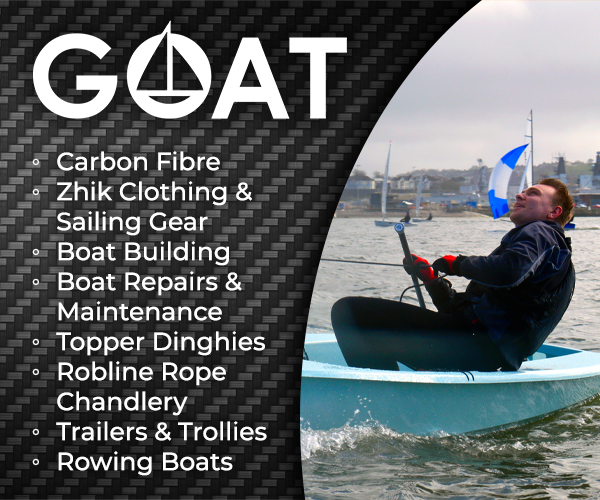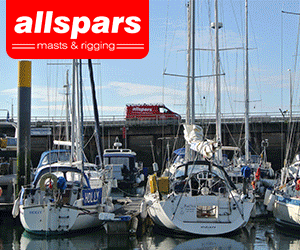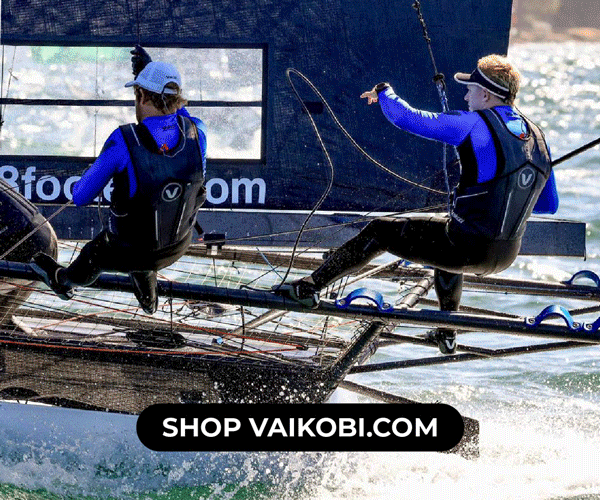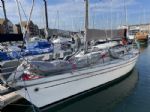












Boats for sale
| Rossiter Pintail Mortagne sur Gironde, near Bordeaux |
 |
| Laser 28 - Excellent example of this great design Hamble le rice |
 |
List classes of boat for sale |
Windward mark: Both must tack |
Post Reply 
|
Page 123> |
| Author | |||||
Brass 
Really should get out more 
Joined: 24 Mar 08 Location: Australia Online Status: Offline Posts: 1151 |
 Post Options Post Options
 Quote Quote  Reply Reply
 Topic: Windward mark: Both must tack Topic: Windward mark: Both must tackPosted: 18 Nov 12 at 10:18pm |
||||
Yes, if it was possible for A to tack back onto port, she might be able to keep clear by doing that.
But with Optis, I would think that there would be a good chance that if A attempted to tack back, whe would end up in irons, right in the headlights.
I wouldn't want to be B in the protest hearing saying 'sure I hunted up and A could have kept clear by tacking back onto Port' unless these were boats that carried some way and I was sure that I could make a good case that tacking back in time to keep clear was possible.
|
|||||
 |
|||||
RS400atC 
Really should get out more 
Joined: 04 Dec 08 Online Status: Offline Posts: 3011 |
 Post Options Post Options
 Quote Quote  Reply Reply
 Posted: 18 Nov 12 at 8:25pm Posted: 18 Nov 12 at 8:25pm |
||||
|
So, boat A, having passed head to wind, must keep clear of B until she is on a close hauled course, (R13). But if B alters couse during this time, R16.1 would mean A be given room to keep clear.
Room to keep clear presumably might not allow A to bear off to close hauled, she might have to go back onto port? |
|||||
 |
|||||
Brass 
Really should get out more 
Joined: 24 Mar 08 Location: Australia Online Status: Offline Posts: 1151 |
 Post Options Post Options
 Quote Quote  Reply Reply
 Posted: 18 Nov 12 at 8:02pm Posted: 18 Nov 12 at 8:02pm |
||||
Good get.
Not so good. At a windward mark, when one of two boats initially on the same tack (with rule 18 applying), changes tack by passing head to wind, boats are on opposite tacks on a beat to windward (or at least the proper course at the mark for one but not the other is [will be] to tack) and rule 18 ceases to apply altogether (rule 18.1( a ) or ( b )). |
|||||
 |
|||||
gordon 
Really should get out more 
Joined: 07 Sep 04 Online Status: Offline Posts: 1037 |
 Post Options Post Options
 Quote Quote  Reply Reply
 Posted: 18 Nov 12 at 5:11pm Posted: 18 Nov 12 at 5:11pm |
||||
|
A on port enters the zone clear ahead. She is entitled to mark room (rule 18.2b), but mark room does not include room to tack.
A passes head to wind and is subject to rule 13. She is no longer entitled to mark-room (18.2c). Until A reaches a close hauled course A must keep clear of B. As B became right of way boat by the actions of A, B is not required, initailly, to give A room to keep clear. There was contact between A and B. A broke rule 13 and should take a penalty. If there was damage to either boat, or injury and B did not attempt to avoid the collision B broke rule 14. |
|||||
|
Gordon
|
|||||
 |
|||||
RS400atC 
Really should get out more 
Joined: 04 Dec 08 Online Status: Offline Posts: 3011 |
 Post Options Post Options
 Quote Quote  Reply Reply
 Posted: 18 Nov 12 at 4:45pm Posted: 18 Nov 12 at 4:45pm |
||||
If B hit the back of A, that suggest to me that A was not yet head to wind, hence still had ROW. If A was clear ahead when she entered the zone, and entered the zone before tacking, B must keep clear. 18.2 b. |
|||||
 |
|||||
Patrick McCosh 
Newbie 
Joined: 29 Oct 12 Online Status: Offline Posts: 3 |
 Post Options Post Options
 Quote Quote  Reply Reply
 Posted: 18 Nov 12 at 4:32pm Posted: 18 Nov 12 at 4:32pm |
||||
|
Last Sunday the optimists approaching windward mark upwind leg all on port after a big windswitch to the left.
No overlap at the zone, lead boat A is clear ahead. Lead boat A tacks onto starboard to round the mark and boat behind (B) collides into back of A before A completes her tack. Who is give way boat ? |
|||||
|
Patrick
|
|||||
 |
|||||
Brass 
Really should get out more 
Joined: 24 Mar 08 Location: Australia Online Status: Offline Posts: 1151 |
 Post Options Post Options
 Quote Quote  Reply Reply
 Posted: 17 Oct 12 at 11:03pm Posted: 17 Oct 12 at 11:03pm |
||||
Edit: Duh! didn't turn the page.
You can assume that R tacked bang on the lay, or you can assume R tacked a little above and M tacked a little below.
Or you can just assume that, since in the OP scenario, nobody is complaining about rule 18.3( a ), that it's a non-issue.
But you're quite right, if R is right on the layline, and she goes above M to avoid contact or to keep clear, then necessarily she is sailing above close hauled. All the more so if R is outside M and M herself sails above close hauled (allowing for the difference in 'close hauled' for each different type of boat).
And you are also right: the limitations of rule 18.3 apply while ever rule 18 applies, that is while ever one of the boats is still in the zone.
To solve the rules 'problem' that piglet asked, you don't really need to explore whether R might have broken rule 15, or rule 11. It suffices to apply rule 18.3 to identify the limitations on M as clear ahead or leeward right of way boat.
You asked 'Was there enough room between M and R to get M round the mark?'. Because there is no entitlement to mark-room (or any other kind of room under rules 15, 16.1, 19, or 20), whether there is room is irrelevant:
Edited by Brass - 17 Oct 12 at 11:06pm |
|||||
 |
|||||
Brass 
Really should get out more 
Joined: 24 Mar 08 Location: Australia Online Status: Offline Posts: 1151 |
 Post Options Post Options
 Quote Quote  Reply Reply
 Posted: 17 Oct 12 at 2:43pm Posted: 17 Oct 12 at 2:43pm |
||||
Quite right, assuming R was smack on the lay, except:
But it's just your assumption, not in the original scenario, that R was smack on the layline: she might just as well have bee a bit above it.
Correct. L/M isn't. It does.
To help maintain our sanity, and avoid endless chains of speculation, there's a convention in judges exams that if the original scenario doesn't contain the facts necessary to establish any particular breach of the rules, then to assume that the facts did not support that breach. Not always appropriate when answering web-posts, but we can probably rely on it here. R isn't complaining about anything, it's M getting upset about being 'forced' into the mark. Also, sometimes it isn't helpful to go exploring a possible breach that would have required a valid protest that probably wasn't hailed for.
All good questions if we want to get to a 'complete' analysis, and if answered, will readily lead to the right answers. |
|||||
 |
|||||
piglet 
Really should get out more 
Joined: 04 Jan 07 Online Status: Offline Posts: 514 |
 Post Options Post Options
 Quote Quote  Reply Reply
 Posted: 17 Oct 12 at 11:30am Posted: 17 Oct 12 at 11:30am |
||||
|
I must confess to being 110 miles away at the time, but, based on my understanding of the scenario:
JimC wrote: The trouble I am having with this is that from my image of what happened I don't really see that the Radial could have been far away enough from the Merlin to put a legal tack in
R maintains he tacked outside the zone and that M had plenty of time to respond after R hailed.
I suspect M may see it differently, but M did manage to tack without boat contact.
Were M and R overlapped after M completed her tack? Was M on the layline or below it?
Yes they were overlapped, M never made it to the layline.
Why did M get tangled in the mark? Was it avoiding a collision because R didn't keep clear, or was it, with little way on after tacking and (possibly) below the lay line, they plain couldn't get round the mark?
M was forced to tack early to keep clear of R and plain couldn't get round the mark.
Did R have to sail above close hauled at any time to keep clear?
No, R stood on, he doesn't pay the bills. Was R bang on the lay line or above it?
Bang on.
Was there enough room between M and R to get M round the mark?
No, R had shut the door.
Don't forget the tide pushing them both back towards the mark, hence M's predicament.
Thanks chaps, this is good.
|
|||||
 |
|||||
JimC 
Really should get out more 

Joined: 17 May 04 Location: United Kingdom Online Status: Offline Posts: 6661 |
 Post Options Post Options
 Quote Quote  Reply Reply
 Posted: 17 Oct 12 at 8:42am Posted: 17 Oct 12 at 8:42am |
||||
|
OK, you need to explain that to me a bit more... I see the non-applicability of 18.2, that's clear enough, but the first bit of 18.3a troubles me.
My emphasis. Assuming that R was smack on the lay line, then in order to get a Merlin (which is some 7 feet wide) round the mark it seems to me that the R is likely to be pushed way above close hauled if the boats are overlapped. So although windward must keep clear, I don't see why that entitles L to luff up to get round the mark if in doing so W must sail above close hauled. Doesn't the restriction on forcing above close hauled continue until the are out of the zone as well as the rstriction on preventing from passing the mark? But I guess we need a few more facts here again. Were M and R overlapped after M completed her tack? Was M on the layline or below it? Why did M get tangled in the mark? Was it avoiding a collision because R didn't keep clear, or was it, with little way on after tacking and (possibly) below the lay line, they plain couldn't get round the mark? Did R have to sail above close hauled at any time to keep clear? Was R bang on the lay line or above it? Was there enough room between M and R to get M round the mark? |
|||||
 |
|||||
Post Reply 
|
Page 123> |
| Forum Jump | Forum Permissions  You cannot post new topics in this forum You cannot reply to topics in this forum You cannot delete your posts in this forum You cannot edit your posts in this forum You cannot create polls in this forum You cannot vote in polls in this forum |
Bulletin Board Software by Web Wiz Forums® version 9.665y
Copyright ©2001-2010 Web Wiz
Change your personal settings, or read our privacy policy
Copyright ©2001-2010 Web Wiz
Change your personal settings, or read our privacy policy












 Printable Version
Printable Version Delicious
Delicious Digg
Digg Facebook
Facebook Furl
Furl Google
Google MySpace
MySpace Newsvine
Newsvine reddit
reddit StumbleUpon
StumbleUpon Twitter
Twitter Windows Live
Windows Live Yahoo Bookmarks
Yahoo Bookmarks Topic Options
Topic Options